India’s annual festival season, characterized by lively consumption patterns and increased spending, has traditionally been a time of exuberance, celebration, and economic prosperity. However, the past few years have presented unprecedented challenges, with the COVID-19 pandemic dampening the festive spirit and financial prospects. Expectations were high for a rebound in 2023, but the festive spending cheer has yet to materialize. A majority of respondents to a recent survey expressed intentions to spend less than the previous year, with most eyeing only small-ticket purchases. What factors have contributed to this unanticipated shift in consumer sentiment?
Understanding the 2023 Festival Season Trends
The festive season in India is a time when households open their wallets for everything from new clothing, electronics, jewelry, and even vehicles. This period has traditionally been a windfall for businesses and marketers, with consumers willing to splurge on a wide array of goods. However, in 2023, a surprising change in consumer behavior has left marketers puzzled.
*1. Reduced Spending Intentions*
The foundation of India’s festival season has been its reputation for lavish spending. However, data from a recent survey indicates that the majority of consumers plan to spend less than they did in previous years. This is a stark contrast to the anticipation of a rebound in festive spending after the pandemic.
*2. Small-Ticket Purchases Dominating*
In a notable shift, consumers are now more inclined to make small-ticket purchases. Instead of investing in big-ticket items, they are opting for smaller, more affordable products. This transformation reflects a more cautious approach to spending and a shift towards more frugal consumption habits.
Factors Behind the Dampened Festive Cheer
Several factors may help explain this unexpected shift in consumer sentiment during India’s annual festival season.
*1. Ongoing Conflict in West Asia*
One significant influence on consumer sentiment in 2023 is the ongoing conflict in West Asia. Geo-political instability and the threat of rising energy costs have raised concerns about the economy. With uncertainties regarding oil prices and its downstream effects on inflation, consumers are wary of overindulging during the festive season.
*2. Lingering Effects of Inflation*
The trail of a long inflationary period has made a lasting impact on consumers’ purchasing power. Rising prices in essential commodities and services have eroded the disposable income of many households. This financial strain has translated into a more cautious approach to spending, particularly during the festival season, which is notorious for its price hikes.
*3. Psychological Impact of the Pandemic*
The psychological impact of the COVID-19 pandemic continues to cast a shadow over consumer behavior. While the worst may be over, many consumers remain wary of economic uncertainties. The memories of job losses, pay cuts, and financial difficulties experienced during the pandemic still linger, leading to a conservative outlook on spending.
Challenges and Opportunities for Marketers
In light of these shifting trends, marketers and businesses need to adapt to the new reality of India’s festival season. While challenges abound, there are also opportunities to cater to changing consumer preferences.
*1. Emphasis on Value and Discounts*
With consumers gravitating towards smaller, more affordable purchases, businesses should emphasize the value they offer. Discounts, promotions, and bundled offers can help attract price-conscious shoppers.
*2. Diversifying Product Offerings*
To cater to the changing consumer sentiment, businesses can diversify their product offerings to include more budget-friendly options. This might mean introducing smaller-sized variants of products, creating special festival-themed packages, or launching lower-cost product lines.
*3. Addressing Inflation Concerns*
Marketers can engage with consumers by addressing their concerns about inflation. Offering transparent pricing, loyalty programs, and inflation-resistant product lines can help ease customer anxieties and encourage spending.
*4. Online and Offline Integration*
As the pandemic accelerated the shift to e-commerce, it’s essential for businesses to maintain a strong online presence. However, they should also recognize the importance of a seamless integration between online and offline channels, allowing customers to shop in the way they feel most comfortable.
*5. Engaging Content Marketing*
Creating engaging and informative content that resonates with the consumer’s festival experience can foster stronger brand loyalty. Content that highlights the cultural and emotional aspects of the festivals can connect with consumers on a deeper level.
The unexpected decline in India’s festival season spending in 2023 has posed challenges for businesses and marketers alike. Multiple factors, including ongoing geopolitical conflicts, inflation, and pandemic-related psychological impacts, have reshaped consumer sentiment. However, this changing landscape also presents opportunities for businesses to adapt, diversify, and connect with consumers in innovative ways. While the path forward may be uncertain, understanding and responding to these evolving consumer trends is crucial for success in the ever-evolving marketplace. Marketers and businesses that can adapt to these new dynamics will likely find themselves better positioned to thrive in India’s evolving festival season landscape.
Disclaimer: The thoughts and opinions stated in this article are solely those of the author and do not necessarily reflect the views or positions of any entities represented and we recommend referring to more recent and reliable sources for up-to-date information.









